Reviews
The Whitney Biennial Can’t Go on Like This Forever
"Even Better Than the Real Thing" feels steeped in a larger climate of retreat and exhaustion.
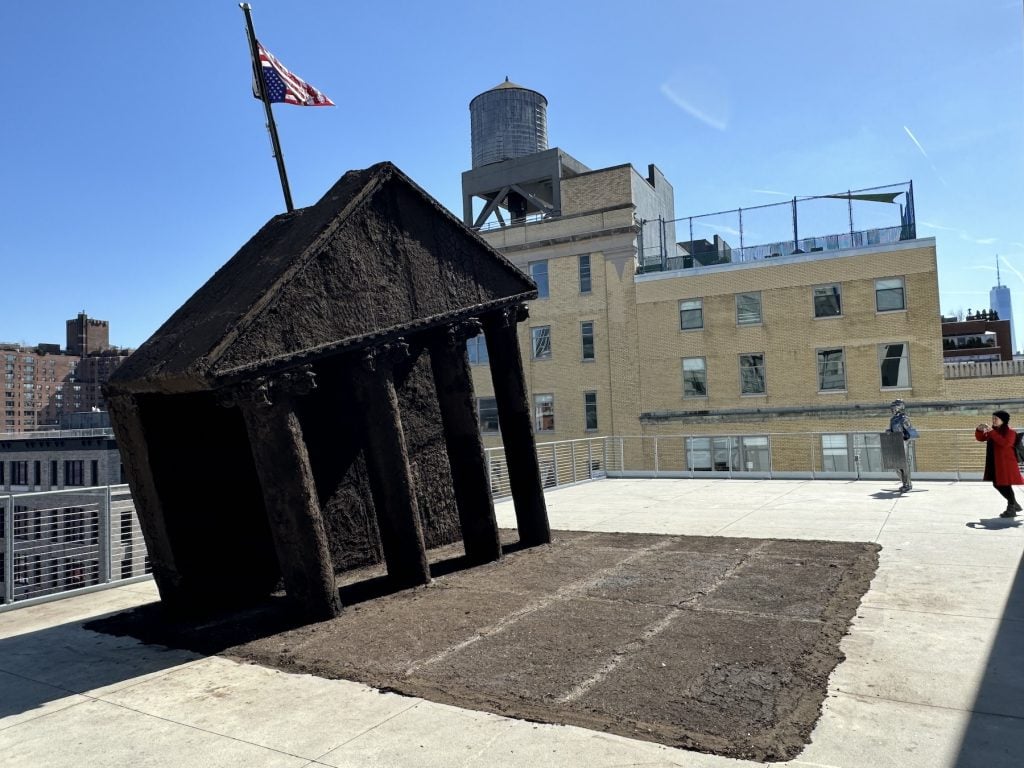
"Even Better Than the Real Thing" feels steeped in a larger climate of retreat and exhaustion.

Ben Davis

What’s on the Whitney Biennial’s mind this year?
In the museum’s ground-floor gallery, the show begins with an American flag, crumpled and dead on a grimy piece of sectional sofa, courtesy the youngest artist in the galleries, the budding art star Ser Serpas (born 1995). It feels like a found-object political cartoon for “the exhaustion of the American dream,” a sentiment felt by a lot of the rising generation.

Assemblage by Ser Serpas at the 2024 Whitney Biennial. Photo by Ben Davis.
The show comes to a climax in one of its few truly photo-worthy images, Kiyan Williams’s Ruins of Empire II or The Earth Swallows the Master’s House (2024), a sculpture of the north facade of the White House, made of earth, listing like a ship going under. An upside-down American flag flutters in the wind.
At first, I thought Williams’s sculpture was a little obvious. On second thought, I realized it was very ambiguous. What, exactly, is being pulled down here? The “master’s house” of the title—as in the bad, corrupt, bigoted America?
Maybe. But the White House seems made of earth, not being swallowed by the earth. This double of the White House—the alternative, the reversal, the imagined negative image of the bad, corrupt, bigoted America—is what appears to be in the process of collapsing, like the limp flag on Serpas’s couch.
This kind of ambiguity—intentional and unintentional—permeates the 2024 Whitney Biennial, which is called “Even Better Than the Real Thing” and curated by Chrissie Iles, a veteran Whitney curator who also co-organized the 2004 and 2006 biennials, and Meg Olni, a curator-at-large there. The artists here seem to both claim art as a form of resistance and feel all resistanced out. Which fits the moment where art’s core audience seems both transfixed by politics and exhausted, oscillating between urgency and futility.
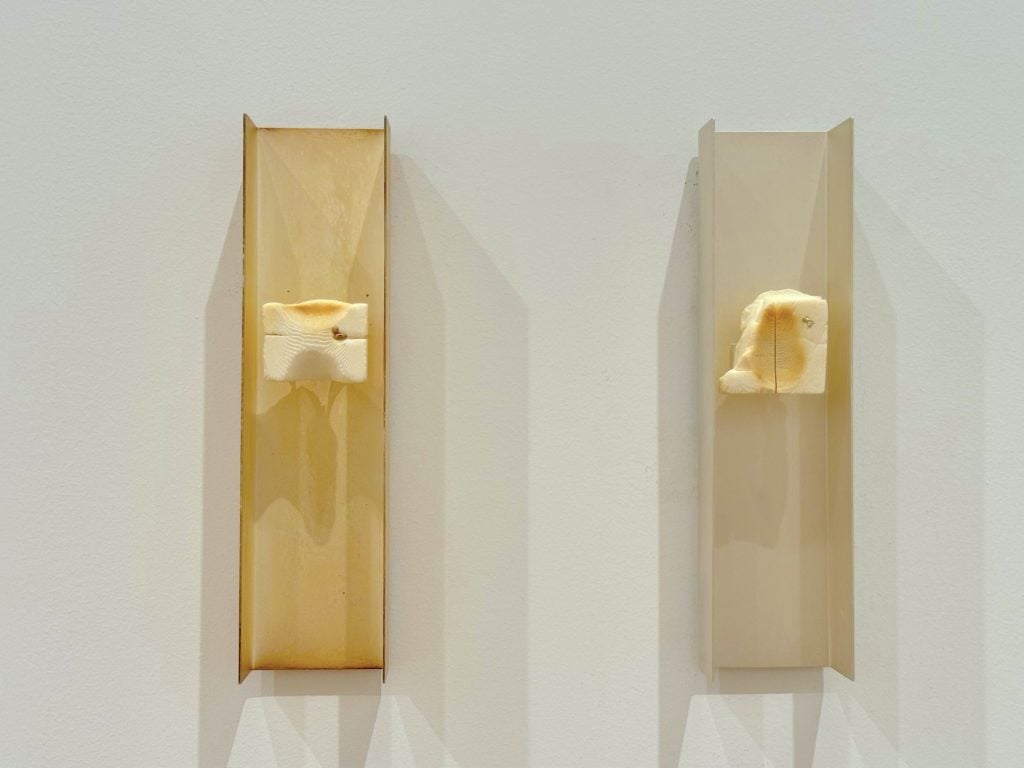
Works by K.R.M. Mooney. Photo by Ben Davis.
Everything here feels slightly withdrawn, alluding to an experience held out of range. Big or small, the sculpture of the 2024 Whitney Biennial is a sculpture of fragments, ruins, and quirky bits of things that telegraph absences or aspire to a material state so specific that it is hard to describe or explain.
As for the film, it is almost uniformly in a vein of historical lecture or healing ritual, ranging from flatly didactic to lightly lyrical, with a lot of hushed, halting narration. The painting is all abstract or abstract-adjacent.
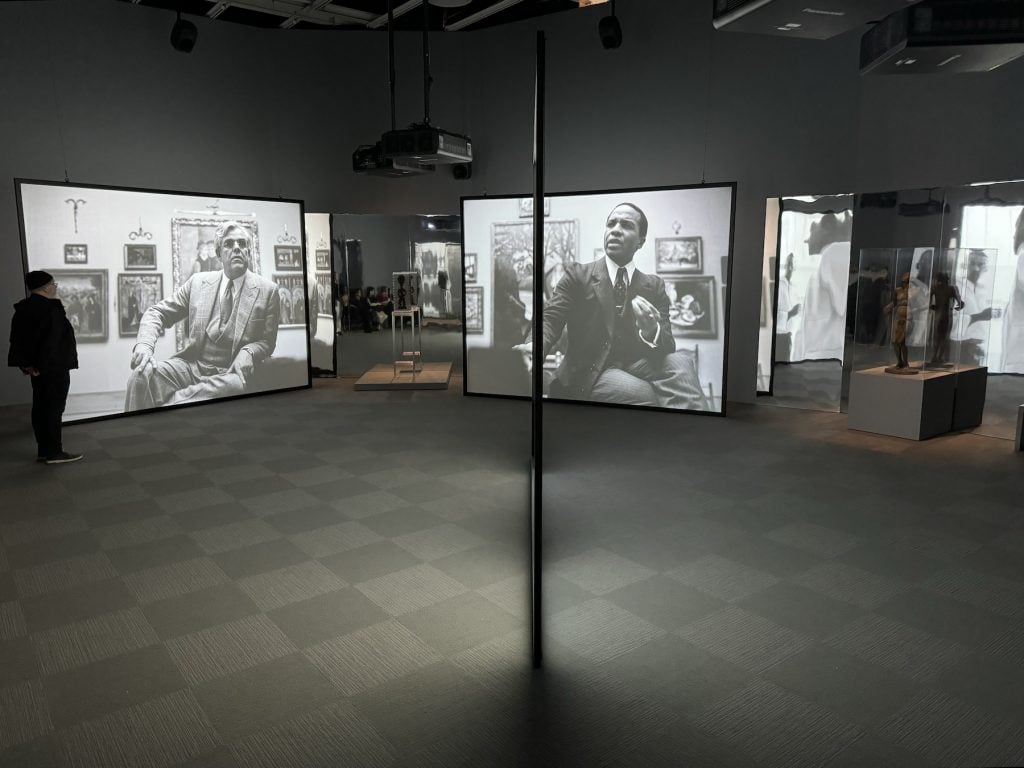
Installation view of Isaac Julien, Once Again… (Statues Never Die) (2022). Photo by Ben Davis.
Notable trends include casting body parts (B. Ingrid Olson, Jes Fan, Julia Phillips) and the taking of rubbings (Dala Nasser, Dora Budor)—both techniques that are about expressing an intimate, direct experience of something past, bearing the trace of that experience but suggesting rather than representing it.
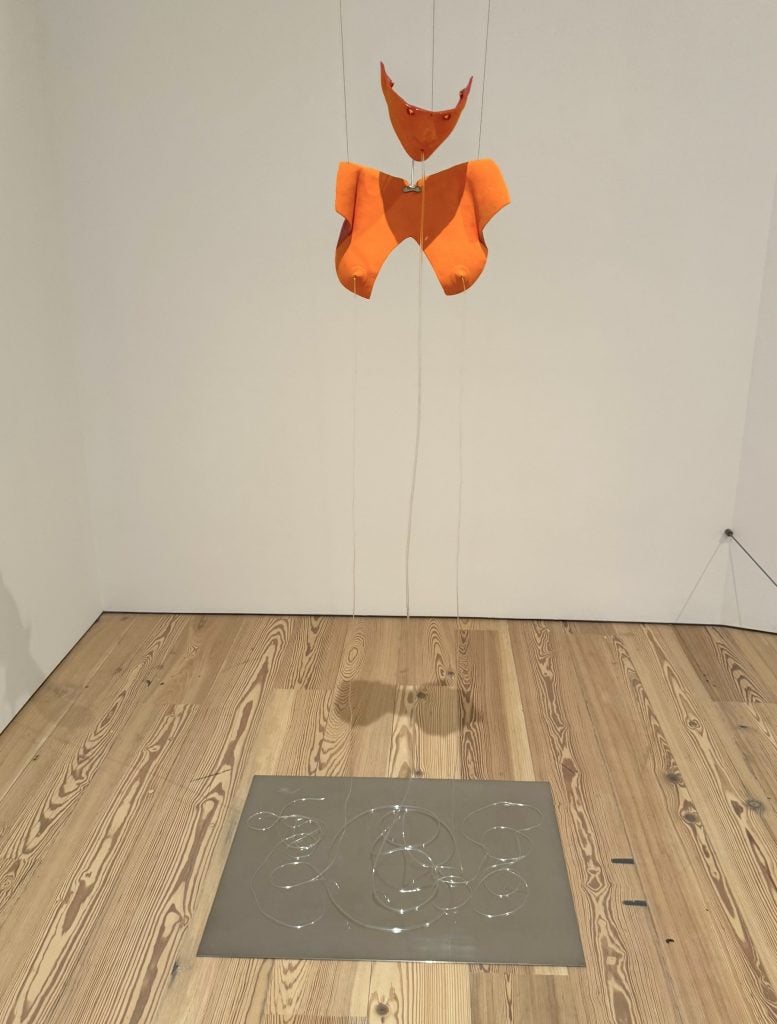
Julia Phillips, Nourisher (2022). Photo by Ben Davis.
A variety of works also make a point of referring to an imperceptible decay or unspectacular flux in their material state that will unfold over time, as if to suggest resistance to any direct and immediate expression (Eddie Rudolfo Aparicio, K.R.M. Mooney, Lotus L. Kang).
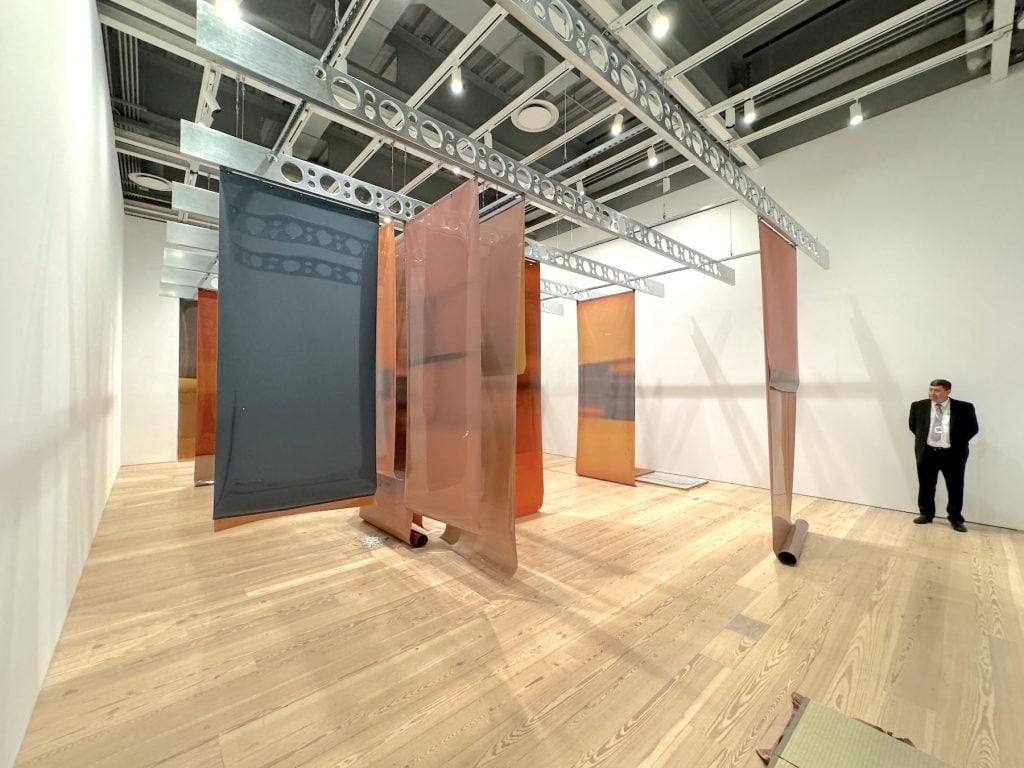
Installation view of Lotus L. Kang, In Cascades (2023-24). Photo by Ben Davis.
Unlike biennials past, there’s almost no photography here, which I find telling. Where it appears, it’s quite deliberately to negate visibility rather than affirm it, e.g. P. Staff’s ghostly self-portrait wallpaper with their face covered, or B. Ingrid Olson’s elliptical photo works, showing fragments of the artist’s own body, barely visible in the studio.
The exception that proves the rule is Carmen Winant’s wall of photos capturing the daily work at abortion clinics. The sheer mass of documentation blurs into one collective portrait, as if to give the individuals the protection of the group. And even there, a point is made that no patients are depicted without their permission, and that in some cases scenes have been restaged to capture important moments without exposing the original subjects. Visibility is vulnerability.
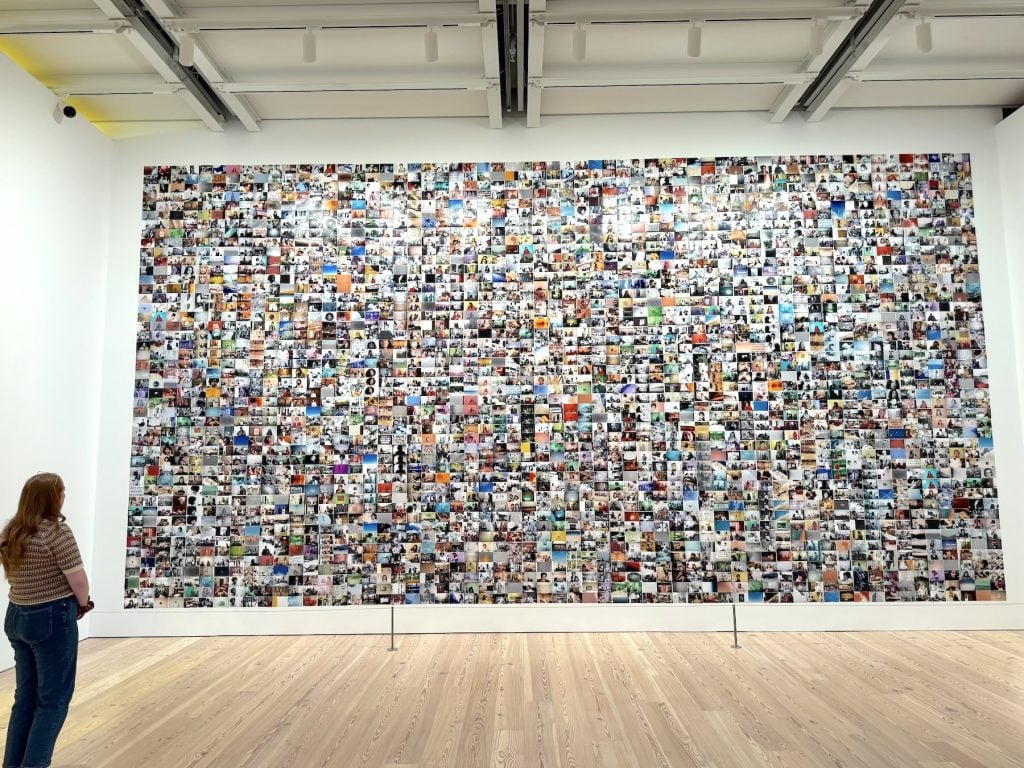
Carmen Winant, The Last Safe Abortion (2023). Photo by Ben Davis.
What is legible as positive representation is almost all about the past, and almost all in the (blessedly few) film installations. These works feel as if they are meant to be educational, while also being too distended and indirect to be great teaching tools.
Much of the film is about looking back, recalling some historical figure—usually from the pantheon of radical history (Madeleine Hunt-Ehrlich on Suzanne Césaire, Isaac Julien on Alain Locke, Tourmaline on Marsha P. Johnson)—and creating a video essay that somehow feels like both homage and lament.
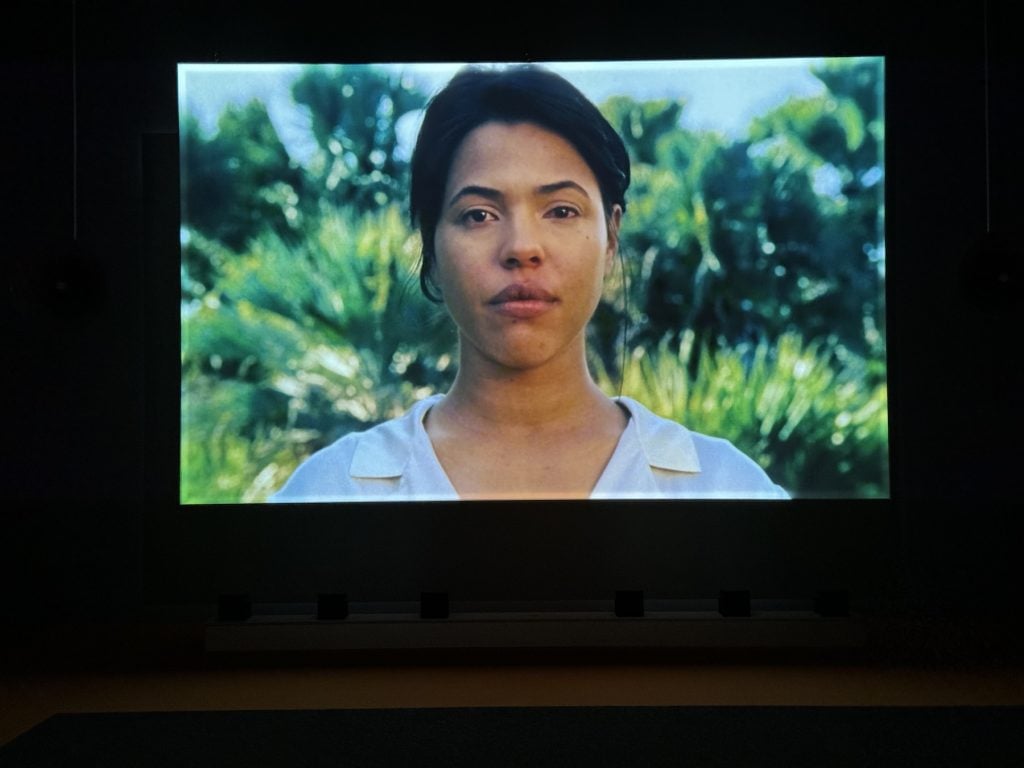
Installation view of Madeleine Hunt-Ehrlich, Too Bright to See (2023-24). Photo by Ben Davis
It occurs to me that all this sounds a lot like I am also describing the last Whitney Biennial, from 2022.
In spirit, the 2024 show fits the previous edition’s title, “Quiet as It’s Kept,” much better than “Even Better Than the Real Thing,” which rings too defiant and optimistic for this show. The cardinal themes are the same—opacity and invisibility, honoring radical elders, non-canonical abstraction, healing rituals—though the previous biennial had more going on, particularly with experimental media (the Berlin-based duo Holly Herndon and Matt Dryhurst’s A.I. experiment is the exception here, and it feels completely on its own, unsupported by any of the other work). The present biennial feels like it has drilled even deeper into one specific vibe of atonement and withdrawal, into “a rhetoric of difficulty, of holding space but also retreating from legibility,” as I said in 2022. It feels as if art has curled itself up into a ball.
Well, I am sure a lot of people feel like curling up into a ball right now.
Beneath all the diverse modes of retreat, what is on this show’s mind is actually not at all ambiguous, and it’s pretty clear exactly when the atmosphere that is now all-pervasive kicked in. I looked back at my take on the 2017 Whitney Biennial, a show that was planned before the election of Donald Trump, but arrived after. My review—which came out before the thunderstorm of paralyzing controversy over the 2016 painting by Dana Schutz, Open Casket—was titled “The Whitney Nails a Balancing Act Biennial.” It reflected my sense that the show felt relevant to a turbulent moment but that it also contained art of an engaging variety, some groovy, some punk, some angry, some mournful, some healing, some troubling.
Amid the disorienting crosscurrents of protests of Trump and protests of museums themselves as bastions of power in the years that followed, the Whitney Biennial—and a lot of biennials, for that matter—shifted into its present register, where “the reckoning” became the implicit main theme. (The fact that this is a sharp narrowing is reflected by the fact, which a lot of curators will complain about, that the cadre of artists in the 2024 Biennial is very familiar from other similar recent events.) As the historian Matt Karp wrote in his 2021 essay “History as End,” a project of perpetually pondering the sins of the past came to dominate at a time when any path toward a better future was frustrated in the mainstream liberal cultural imagination. The goal of culture became to signal awareness of the magnitude of the world’s brokenness, and to cope.
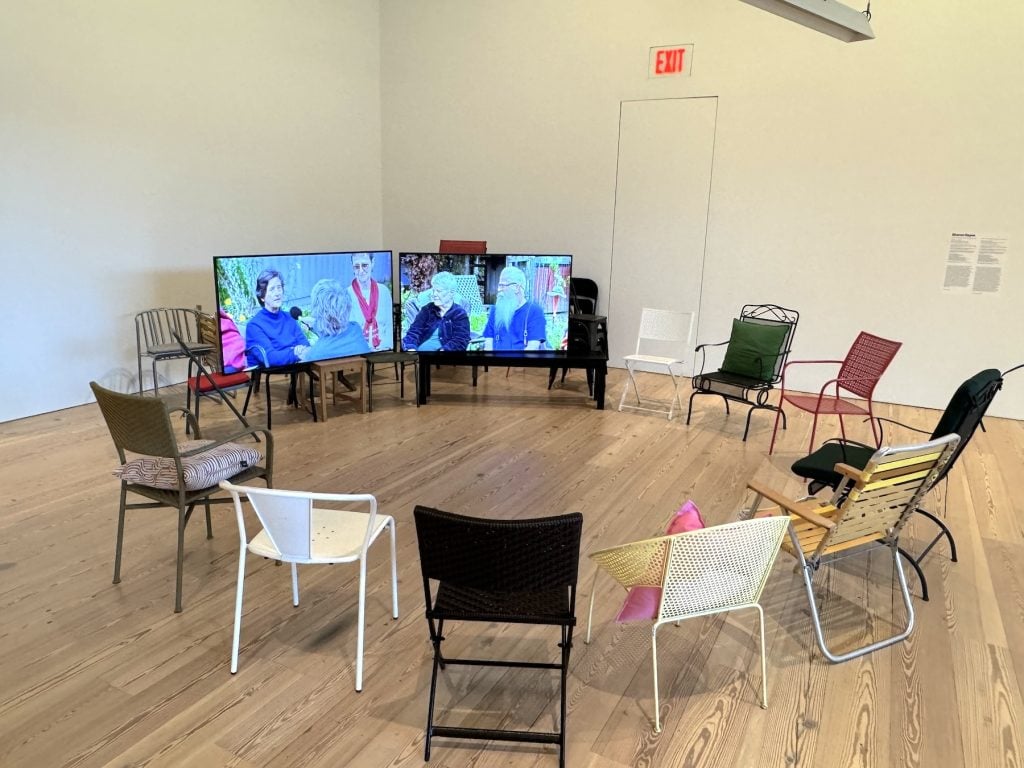
Sharon Hayes, Ricerche: four (2024). Photo by Ben Davis.
Sharon Hayes has a video here, Ricerche: four (2024), unspooling a group conversation with queer elders in Tennessee, where demagogic politics targeting gender nonconforming people are ascendant. There’s a moment that hit me, as they recall the loss of spaces of community—how there used to be many gay bars and how the options are now so limited. (Incidentally, the 2022 biennial also had a Nayland Blake work that was a tribute to a lost gay club.) Hayes’s installation is ringed by chairs where visitors can gather to watch this conversation, and in general the installation captures the sense of an art trying, through the force of its good intentions, to make up for lost real spaces of possibility.
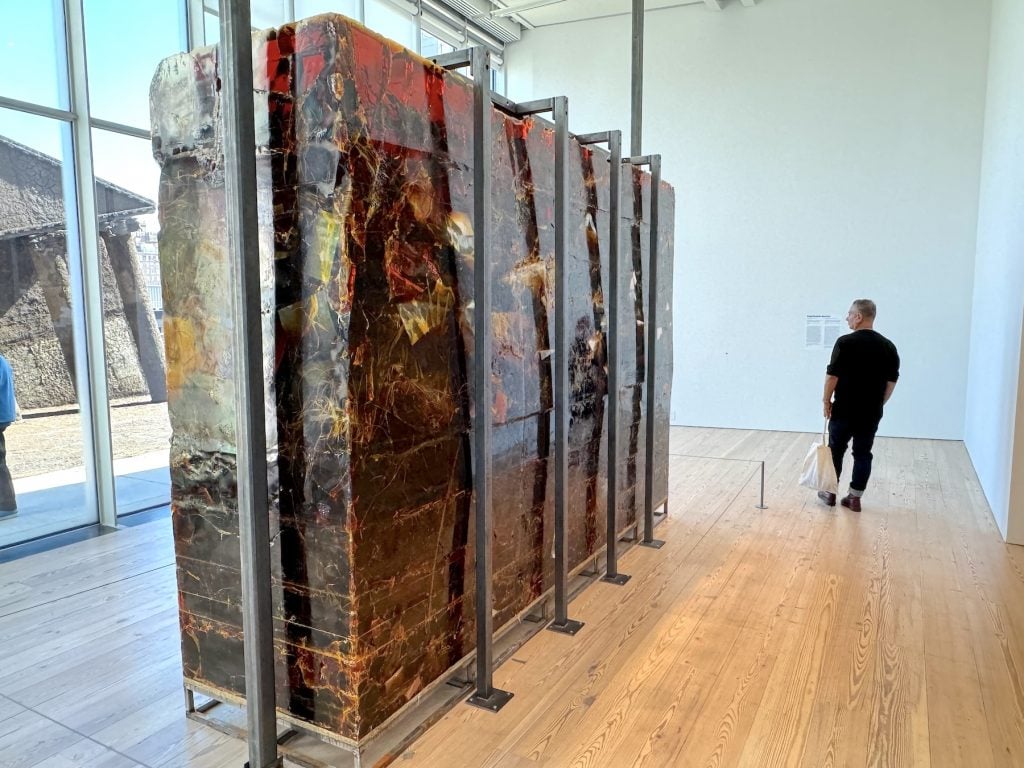
Eddie Rudolfo Aparicio, Paloma Blanca Deja Volar/White Dove Let Us Fly (2024). Photo by Ben Davis.
But we all know that something so modest as an art show is not up to the enormous scale of the problems of a world that is degenerating fast. That disjunction makes any symbolic act feel “performative,” like empty theater. The art here is explicitly summoned to speak for the concerns of the marginalized—that’s what the curators say this biennial’s main mission is as you step into the galleries, in the show text. But the art itself seems suspicious of or indifferent to giving an art audience anything like easily consumable content to make it feel virtuous or righteous (indeed, one function of the interest in historic abstract painting by Black artists is to provide the occasion to remind us that the demand to represent Black struggle has been a burden).
What results, overall, is a kind of “I can’t go on/I must go on” sensibility. The show characteristically avoids both outrage and joy, instead conveying a restrained and depressive air.
Eddie Rudolfo Aparicio’s monolith made of amber is actually embedded with scraps of documents, which, we are informed, were “produced by white activists in Los Angeles and New York looking at the complex relationship between privilege and solidarity.” Unable to understand what this meant, I went to the audio guide, where the artist says he feels like we are stuck in history, “how time and history is very cyclical,” with today’s struggles of Central American migrants mirroring struggles from the past. He does say we should learn from the inspiring examples contained in the texts here. Yet in the galleries, it is impossible to make out what any of the texts are, as if the form of the art itself were pushing back against the thought, conceding we are stuck.
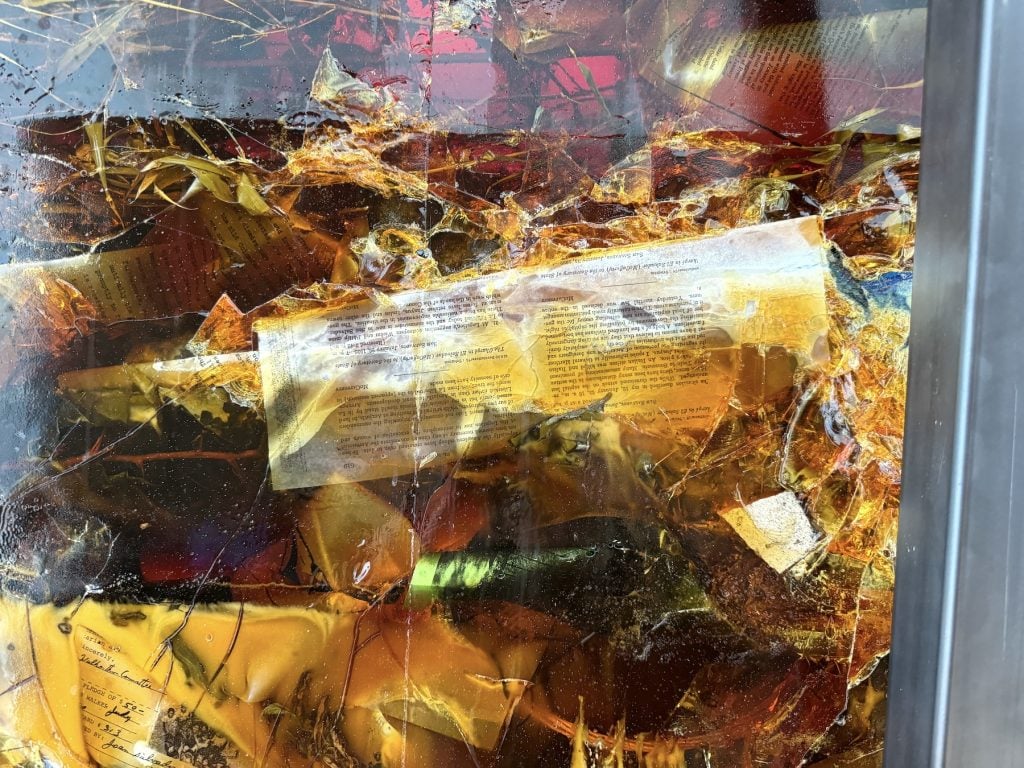
Detail of Eddie Rudolfo Aparicio, Paloma Blanca Deja Volar/White Dove Let Us Fly (2024). Photo by Ben Davis.
So far, the critical reaction to this show has been “meh.” That’s my first impression, too, though as with “Quiet as It’s Kept,” when I dig in, I find more to love (though I ultimately liked “Quiet as It’s Kept” more). To be clear, I don’t find the big themes of “Even Better Than the Real Thing” objectionable, on their own. But, also, there’s more going on in contemporary art than mournful post-conceptualism and personal ritual. I do think that it is a big mistake that biennials have given themselves over so completely to one vibe, which robs even good works in this vein of the contrast they need to connect.
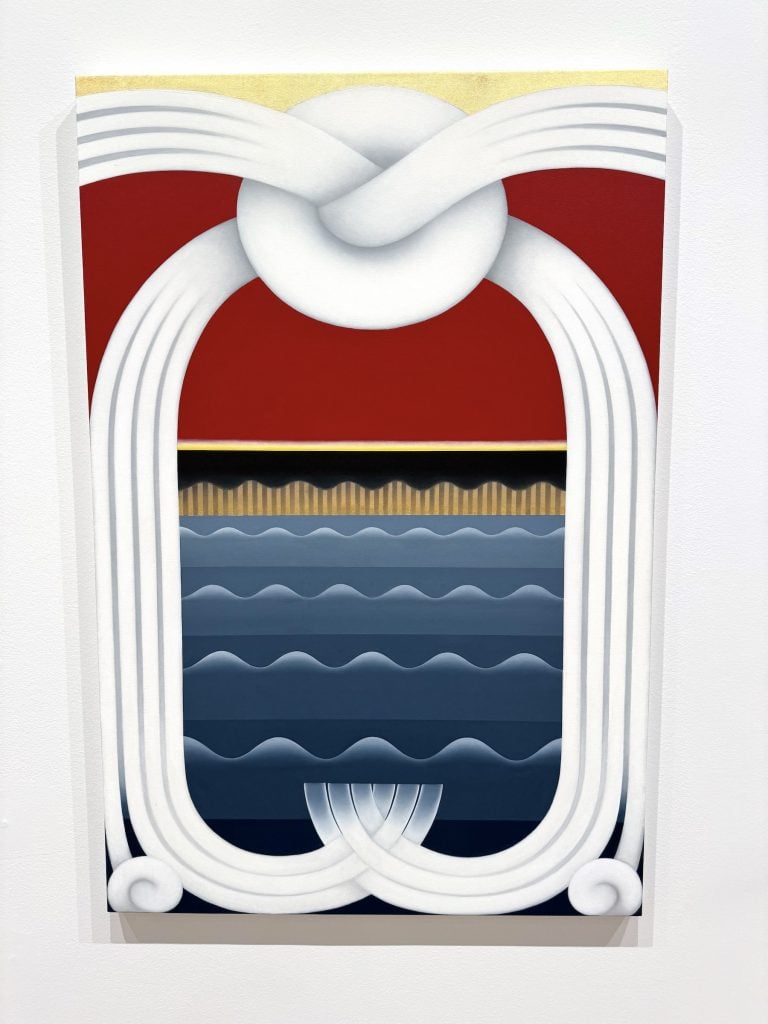
Takako Yamaguchi, Clasp (2022) in the Whitney Biennial. Photo by Ben Davis.
Because of the lack of contrast, I guess the works that stand out for me most are the ones that cut a bit against those dominant tones. The hard-edged, stylish geometric landscape paintings by Takako Yamaguchi are very pleasurable, with a lot of crystalline visual beauty.
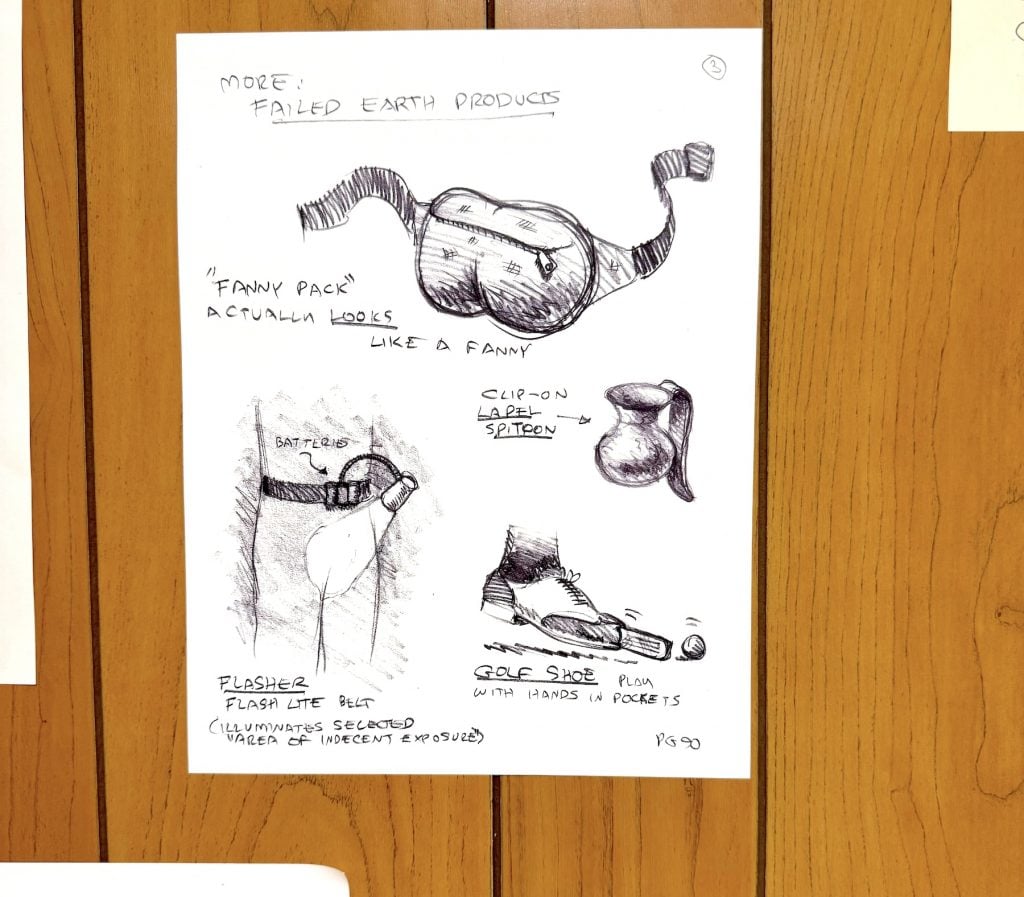
Detail of Pippa Garner, Inventor’s Office (2021). Photo by Ben Davis.
Down on the third floor, I appreciate the wall of fake product pitches by Pippa Garner, an elder artist here (b. 1942). These are the only really funny works in the show, and in their occasional lustiness and consistent wackiness, cut against the somber, ethical aura of a lot of the rest.
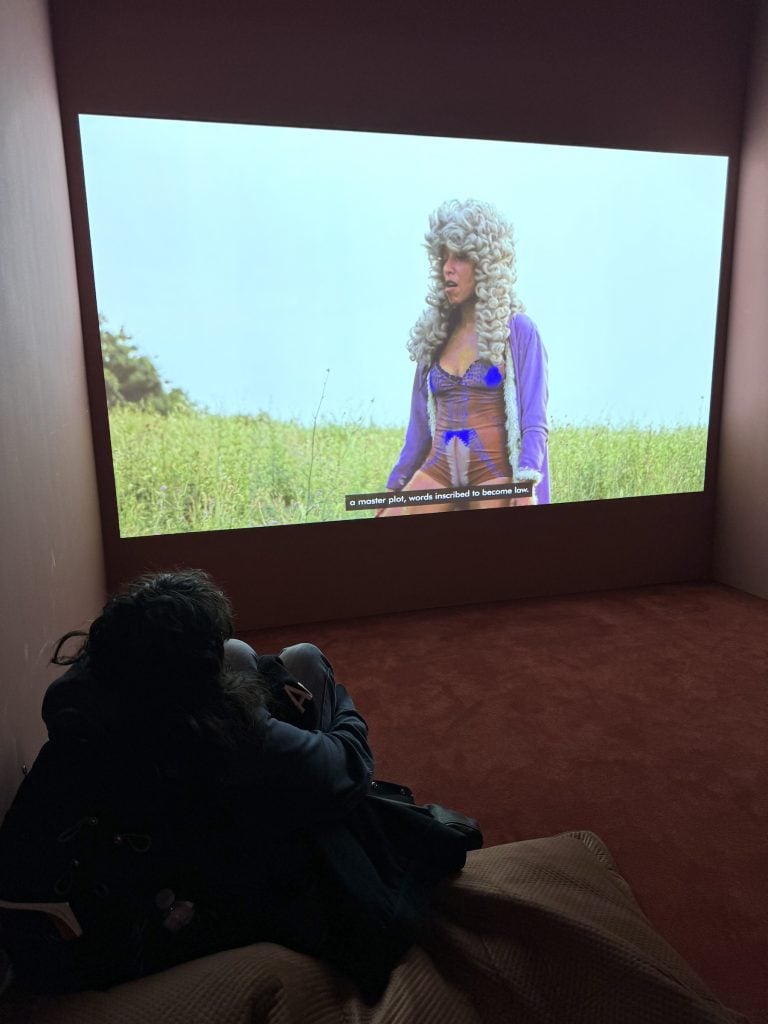
Installation view of Ligia Lewis, A Plot, A Scandal (2023). Photo by Ben Davis.
Of the film installations, Ligia Lewis’s work is burdened with a text I could not make sense of before watching, and can only barely make sense of after (“Utopian or mundane, how might scandal reveal what lies unwittingly close to our fantasies? Is it the demand for repair? Or the otherwise brutish desire for revenge?”) But its subject, the practice of 19th-century Dominican Vudú, is interesting, and the use of dancers to act out an aggressive, bawdy burlesque of European colonial authority has an in-your-face, unnerving edge.
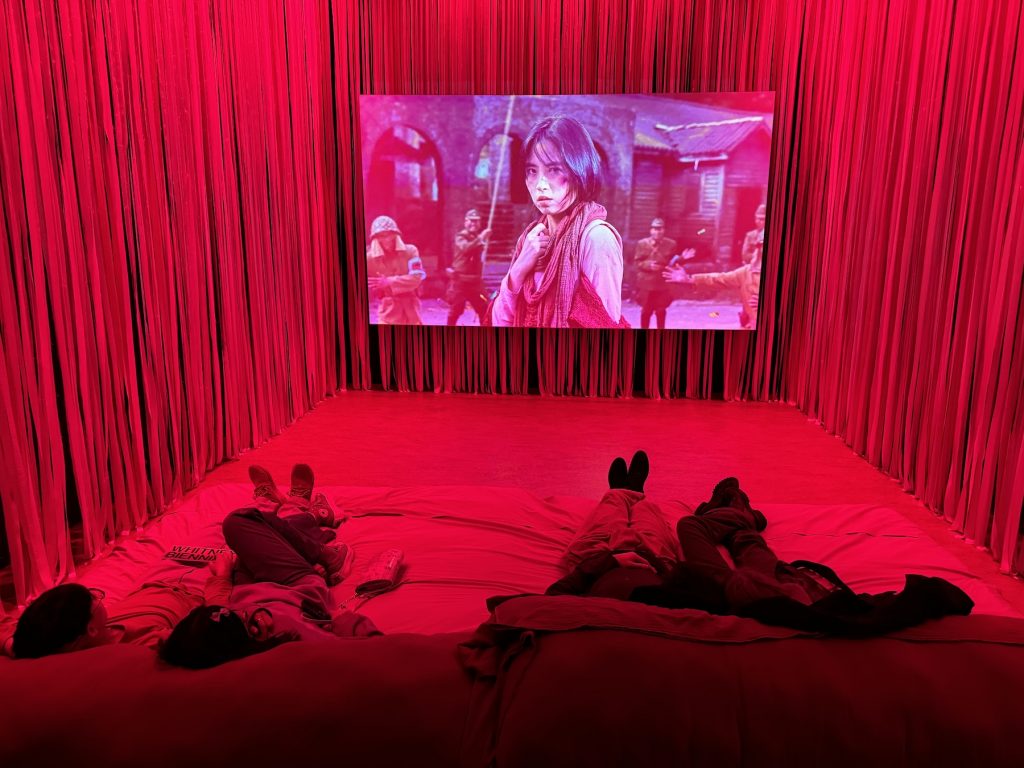
Diane Severin Nguyen, In Her Time (Iris’s Version) (2023-24). Photo by Ben Davis.
I also appreciate Diane Severin Nguyen’s hour-long film about a young woman who goes to work in the Chinese film industry, chasing dreams of being discovered as a star via her role as a background player in an epic film about the Nanjing Massacre, one of the most brutal military crimes of the 20th century. You hear the woman, Iris, talk about her aspirations; see her dutifully studying the gruesome history in her tiny apartment; watch her playact choking herself with a cord, as if internalizing her allotted role.
On a meta level, I think Nguyen’s film highlights the mix of perversity and melancholy of a culture built on revisiting, over and over, historical tragedy. But it also avoids the total cynicism that could come with that thought.
Finally, the most-talked-about work of the show will certainly be Demian DinéYazhi’s neon text-art signs flickering phrases such as, “We must stop predicting apocalypse + fascist governments + fascist hierarchies!” They face the windows on the fifth floor, buzzing out towards the waterfront. Truth be told, I at first considered the actual texts a little grad-student-y, though I appreciate their sentiment. My colleague Annie Armstrong was the first to note that the flickering letters in the sign subtly read out the words “free palestine,” and it turns out that the message was basically smuggled into the biennial without the curators knowing.
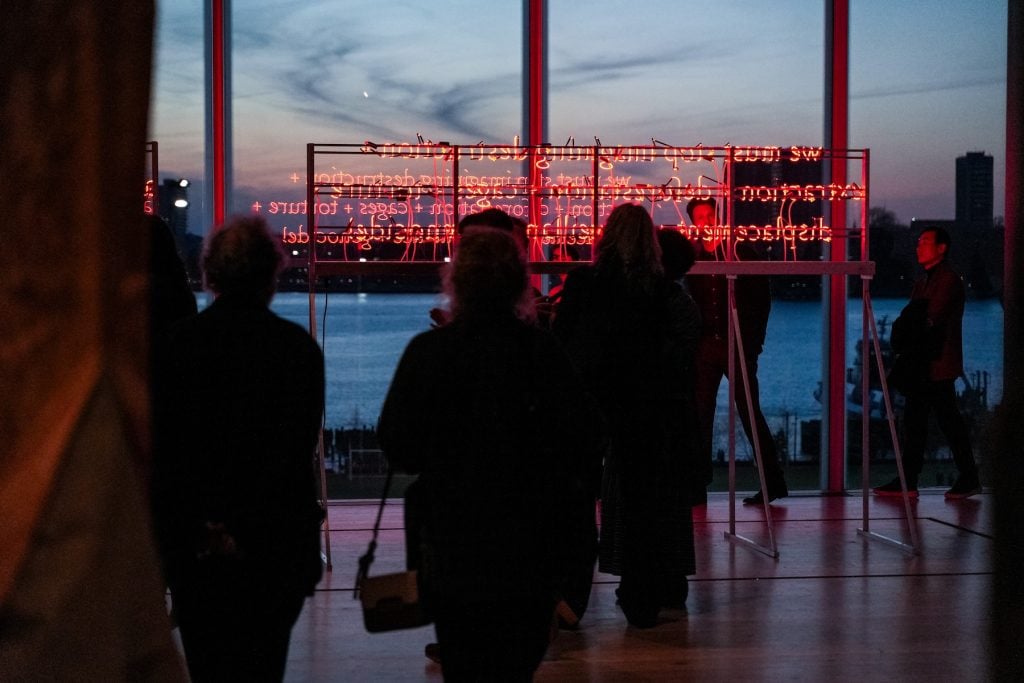
Demian DinéYazhi, we must stop imagining apocalypse/genocide + we must imagine liberation (2024) at the opening of the 2024 Biennial. (Photo by Sean Zanni/Patrick McMullan via Getty Images)
Now I am obsessed with the idea that this smuggling operation is the art. It makes DinéYazhi’s work about the paradoxical invisibility and inescapability of this raging political issue, given the horrifying hourly news from Gaza and the robust repression of antiwar sentiment that has ripped through culture (my god, even Jonathan Glazer, the director who made an impeccable, freshly horrifying movie about the Holocaust, has had his name dragged through the mud for basically saying the equivalent of “not in my name” at the Oscars).
Granted, a hidden message in neon is little to celebrate, given the fact that about a million people face starvation in Gaza right now. “We must stop predicting apocalypse…,” the sign says, even as it also alludes to a vast human disaster unfolding in real time. But I don’t take lightly the potential professional consequences of such gestures. They take courage.
“Whitney Biennial 2024: Even Better Than the Real Thing” is on view at the Whitney Museum of American Art, New York, through August 11, 2024.